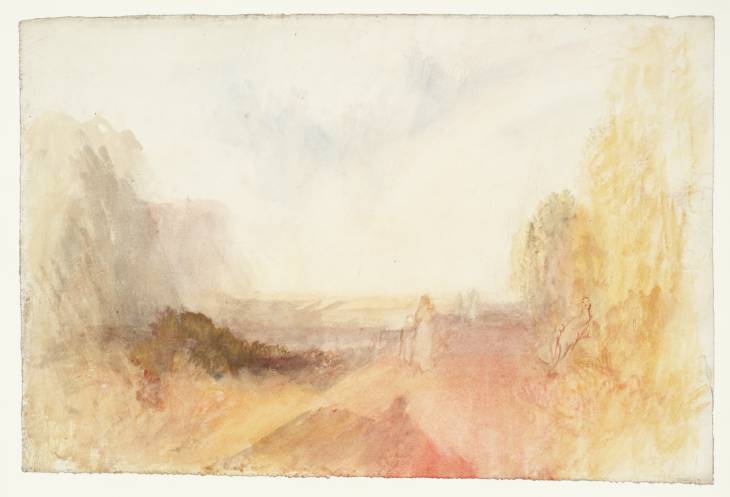Joseph Mallord William Turner The Grounds of New College, Oxford c.1837-9
Joseph Mallord William Turner,
The Grounds of New College, Oxford
c.1837-9
Joseph Mallord William Turner 1775–1851
The Grounds of New College, Oxford c.1837–9
D36314
Turner Bequest CCCLXV 24
Turner Bequest CCCLXV 24
Pencil and watercolour on white wove paper, 343 x 509 mm
Watermark ‘J Whatman | 1837’
Inscribed in red ink ‘24’ bottom right
Stamped in black ‘CCCLXV – 24’ bottom right
Watermark ‘J Whatman | 1837’
Inscribed in red ink ‘24’ bottom right
Stamped in black ‘CCCLXV – 24’ bottom right
Accepted by the nation as part of the Turner Bequest 1856
Exhibition history
1997
Turner’s Watercolour Explorations 1810–1842, Tate Gallery, London, February–June 1997, Southampton City Art Gallery, June–September 1997 (81, reproduced in colour, as ‘New College, Oxford, c.1837–40).
2000
Turner’s Oxford, Ashmolean Museum, Oxford, June–September 2000 (64, as ‘New College: Colour Beginning’, c.1837–8).
References
1909
A.J. Finberg, A Complete Inventory of the Drawings of the Turner Bequest, London 1909, vol.II, p.1213, CCCLXV 24, as ‘Promenade, with figures’, after about 1830.
1992
Maurice Davies, Turner as Professor: The Artist and Linear Perspective, exhibition catalogue, Tate Gallery, London 1992, p.64, fig.68.
1997
Eric Shanes, Turner’s Watercolour Explorations 1810–1842, exhibition catalogue, Tate Gallery, London 1997, pp.12, 13, 26, 86, 88 no.81, reproduced in colour, as ‘New College, Oxford. c.1837–40, p.97 Appendix I under ‘England and Wales Series’, as ‘Sketch of New College, Oxford’. c.1837–40, p.100 under ‘Oxford’, as ‘Sketch for an England and Wales series view of New College, Oxford’. c.1837–40, p.107 Appendix II, as ‘Sketch: New College, Oxford’.
2000
Colin Harrison, Turner’s Oxford, exhibition catalogue, Ashmolean Museum, Oxford 2000, p.106 no.64, as ‘New College: Colour Beginning’. c.1837–8.
Eric Shanes has identified this loose colour study as showing New College, Oxford, based on a pencil drawing in the Oxford sketchbook, in use between about 1834 and 18381 (Tate D27939; Turner Bequest CCLXXXV 29a),2 possibly as an undeveloped design for Turner’s Picturesque Views in England and Wales,3 the last engravings of which were published in 1838.
The view is west from within the college grounds, towards the Garden Quadrangle, flanked to the north by the chapel, little of which is hinted at in the very loose pencil work in the distance here. The female figures in the foreground here have approximate equivalents in the pencil study.
Colin Harrison has also dated this, along with other Oxford colour studies, to the late 1830s,4 hence the dating here. Tate D25217 (Turner Bequest CCLXIII 95) shows Trinity College from its own grounds, while Tate D25218 (Turner Bequest CCLXIII 96) shows St John’s College with Trinity beyond. See also the introductions to the present subsection of identified but unrealised Oxford subjects and the overall England and Wales ‘colour beginnings’ grouping to which this work has been assigned.
Maurice Davies has used the present work as an example of Turner’s placing the apparent ‘perspective centre point’ towards the left or right of a composition5 – in this case towards the right, where the edges of the path converge.
Technical notes:
As Eric Shanes notes,1 this is one of four Oxford colour studies which are closely related physically. The present work (watermarked 1837) and Tate D25218 (Turner Bequest CCLXIII 96) have matching serrations at the bottom of their respective compositions where the original super royal-format sheet was torn in half. The two were worked up on opposite faces of the overall sheet, presumably after it was halved, as there is no overlap of watercolour wash from the front of one to the back of the other. All of the above applies to Tate D25220 (Turner Bequest CCLXIII 98) and Tate D25217 (Turner Bequest CCLXIII 95), also originally a single sheet. Shanes observes that ‘all four drawings manifest extremely similar serrations that resulted from the two super royal sheets being torn in half simultaneously’.2 He also suggests that their ‘distinctive, shared characteristics’, along with those of a fifth Oxford study, Tate D36316 (Turner Bequest CCCLXV 26, watermarked 1837), indicate that they ‘may have been made during the same work session’.3
As Eric Shanes notes,1 this is one of four Oxford colour studies which are closely related physically. The present work (watermarked 1837) and Tate D25218 (Turner Bequest CCLXIII 96) have matching serrations at the bottom of their respective compositions where the original super royal-format sheet was torn in half. The two were worked up on opposite faces of the overall sheet, presumably after it was halved, as there is no overlap of watercolour wash from the front of one to the back of the other. All of the above applies to Tate D25220 (Turner Bequest CCLXIII 98) and Tate D25217 (Turner Bequest CCLXIII 95), also originally a single sheet. Shanes observes that ‘all four drawings manifest extremely similar serrations that resulted from the two super royal sheets being torn in half simultaneously’.2 He also suggests that their ‘distinctive, shared characteristics’, along with those of a fifth Oxford study, Tate D36316 (Turner Bequest CCCLXV 26, watermarked 1837), indicate that they ‘may have been made during the same work session’.3
Technical notes:
Very slight, loose vertical and horizontal pencil lines hit at architecture at the centre of the composition.
Very slight, loose vertical and horizontal pencil lines hit at architecture at the centre of the composition.
Verso:
Blank, save for inscriptions: in pencil by ?Turner ‘38’ in circle at centre; and stamped in black with Turner Bequest monogram above ‘CCCLXV – 24’ bottom right.
Blank, save for inscriptions: in pencil by ?Turner ‘38’ in circle at centre; and stamped in black with Turner Bequest monogram above ‘CCCLXV – 24’ bottom right.
Matthew Imms
March 2013
How to cite
Matthew Imms, ‘The Grounds of New College, Oxford c.1837–9 by Joseph Mallord William Turner’, catalogue entry, March 2013, in David Blayney Brown (ed.), J.M.W. Turner: Sketchbooks, Drawings and Watercolours, Tate Research Publication, December 2013, https://www

